the Flemish Renaissance
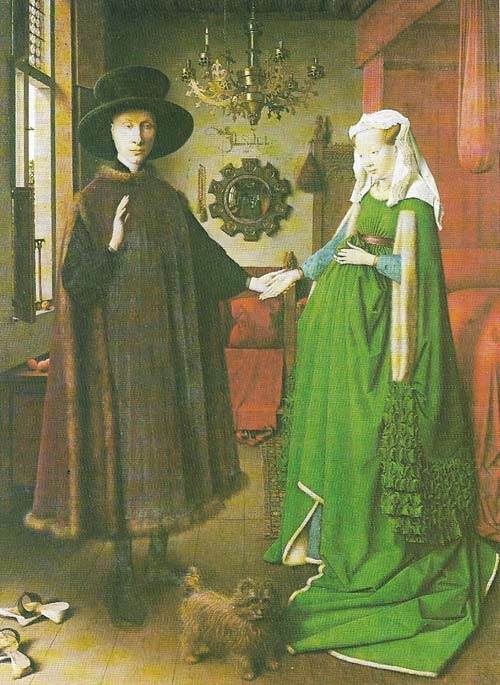
Figure 1. Jan van Eyck's "The Madonna of Chancellor Rolin" (c. 1435) was in the Cathedral of Autun, the home town of Nicholas Rolin, who was also one of the principal patrons of Rogier van der Weyden.
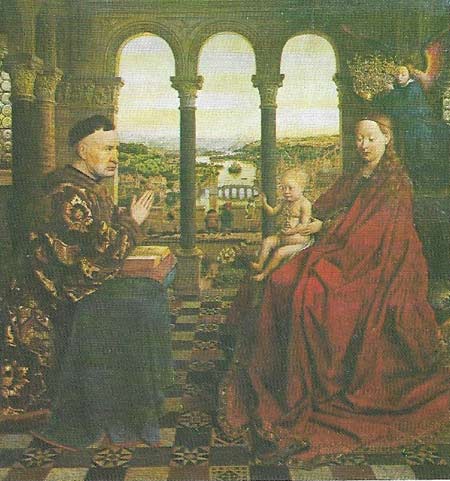
Figure 2. "The Arnolfini Wedding" (1434) is by Jan van Eyck. The signature states "Johannes de Eyck fuit hic" meaning "Jan was here" – that is, was witness to what is clearly a marriage. It is believed that the couple are Giovanni Arnolfini,a merchant from Lucca, Giovanna Cenami. The picture is filled with appropriate symbolism: the marriage-candle a reminder of Christ's presence, the mirror, signifying purity, and the dog fidelity. The statuette on the back of the chair is of St Margaret the patron saint of childbirth.
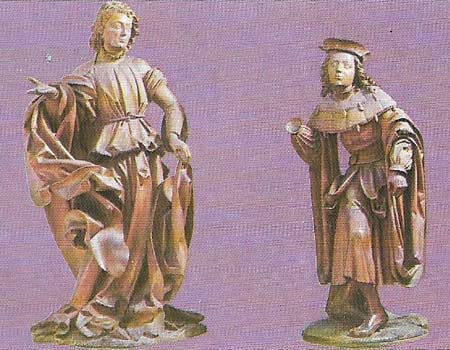
Figure 3. Veit Stoss's "The Archangel Raphael and Tobias" (1516–1518) was commissioned for the Carmelite church in Nurnberg by a Florentine silk merchant, who undoubtedly chose the subject because in Florence Raphael was popularly the guardian angel of travellers. In this sculpture the natural beauty of the material is revealed, and not covered by the usual polychrome and gold. It is one of the latest, most vivacious works of Veit Stoss.
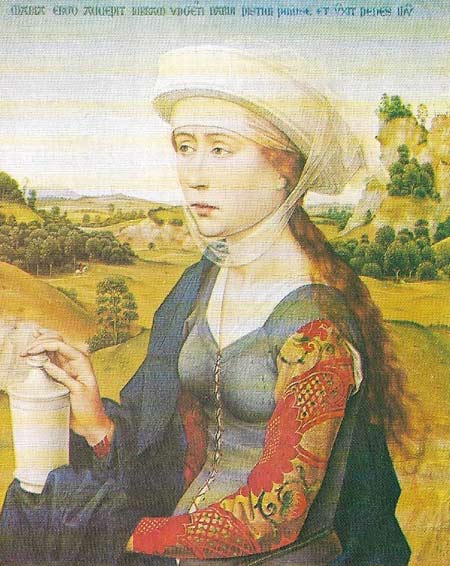
Figure 4. Rogier van der Weyden's "The Magdalen" (c. 1451) is the right wing of a triptych, with Christ in the century flanked by the Virgin and St John, painted for Jean de Braque. The triptych was made immediately after Rogier's return from Italy and the simplicity of style and sense of order may reflect his experiences there.
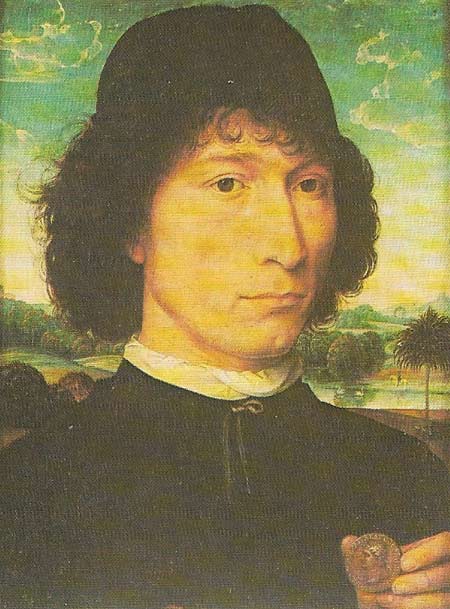
Figure 5. Hans Memling (c. 1440–1494), a German pupil of Rogier, was from 1465 the most successful painter on Bruges, where he enjoyed an international clientele. Several of his portraits were of Italians, such as this one – "Portrait of an Italian" (c. 1480) – and these pictured exerted considerable influence back in Italy. His landscape style was much imitated there. The sitter here may be a medallist, but is more probably a collector.
In the years just before 1400 the two most vital artistic centers in northern Europe were far apart, in Paris and Prague, but the distance made strangely little difference because of a widespread style in court art known by two unsatisfactory but descriptive titles, International Gothic, or the Soft Style, which was also to be found in London and Lombardy. A new beginning sprang from a dynastic event, the union under Philip the Bold of the Duchy of Burgundy with Flanders. This north-south (Bruges-Dijon) axis brought together artists from Flanders, Holland and Germany to form a school that is conventionally called Flemish.
From naturalism to realism
The first phase of the patronage of the dukes of Burgundy was centred on Dijon. Philip the Bold (1342–1404) brought the painter Melchior Broederlam (died c. 1410) from Ypres and the sculptor Claus Sluter (died 1406) from Haarlem and Brussels. The main surviving work by Broederlam is the painted part of a very large altarpiece at Dijon. It is of a kind found all over northern Europe in the fifteenth century, from Burgundy to Poland, and quite distinct from Italian traditions: the main part is polychrome and gilded wood sculpture with a highly wrought Gothic frame, which is enclosed by wings with painted narratives.
Sluter's greatest work was his last, the so-called "Well of Moses" (a Calvary group) in the Charterhouse of Dijon; he developed a strikingly massive and lifelike style, which was to be a characteristic of Burgundian sculpture for a generation.
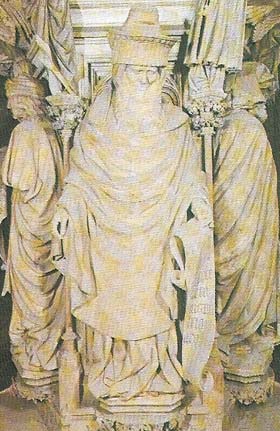 |
| Claus Sluter's "The Prophet Zachaiah"(c. 1401) is one of six prophets round the base, commonly called the "Well of Moses", of a Calvary group of which only fragments survive, begun in 1395 for Philip the Bold. The figures were painted by Jean Malouel; such collaboration between major painters and sculptors was common in the 15th century, when unpainted sculpture was the exception to the rule. |
Philip also employed the most brilliant miniaturists of the time, the Limbourg brothers (from Nimwegen, trained in Paris); but it was for Philip's brother, Jean de France, Duc de Berry, that they made their most celebrated manuscript, the Tres Riches Heures. The narratives in this book reflect the cosmopolitan, especially Italianate, nature of French art at the end of the 14th century, but the calendar pages have a startling naturalism that is quite new. It is upon a firm tradition of panel painting, but newly inspired by sculptors and miniaturists, that the "Flemish" style is based.
The second phase of Burgundian patronage is centred on Bruges, the commercial and banking capital of the north, where Philip the Good (duke from 1419) and his chancellor Rolin employed Jan van Eyck (died 1441) (Figure 1) from 1426, the year in which Jan's brother Hubert died. The enormous painted polyptych "The Adoration of the Lamb" in the Cathedral of St Bavon, Ghent, seems to have been begun by Hubert and finished by Jan in 1432, and it was commissioned by a merchant; Jan also painted for churchmen, the bourgeoisie, courtiers and visiting Italians. His style, still more naturalistic than the Limbourgs' or Sluter's, was technically the most sophisticated and luxurious of its period (Figure 2); while not the first to use oil, he put it to great effect in obtaining strength and transparency of colour, closely observed descriptions of light and texture – as in the sheen on a pearl – and minuscule detail. A contemporary artist of almost equal importance, Robert Campin (c. 1375–1444), worked mainly in Tournai in a tougher, less refined style with strong, expressive and realistic effect; and this style was developed by his pupil Rogier van der Weyden (1400–1464) (Figure 4), who established in Brussels the most important mid-century workshop.
Enrichment of tradition
Exchange of artistic ideas between Italy and the Low Countries in the 15th century left the Flemings richly in credit. The three founders of the Flemish school were followed by a host of painters operating in the Low Countries in the second half of the century, who enriched the tradition and maintained its prestige; but the Flemish "rebirth" also revitalized German painting, which for the first half of the century was in general an independent development from the Soft Style. The decisive change here came through the influence of Rogier, particularly upon Martin Schongauer (c. 1450–1491) who worked mainly in the upper Rhine around Colmar. Schongauer was not only, as painter and draftsman, the principal inspiration for Diirer, but also the first great engraver (from c. 1470); through this medium his influence was international.
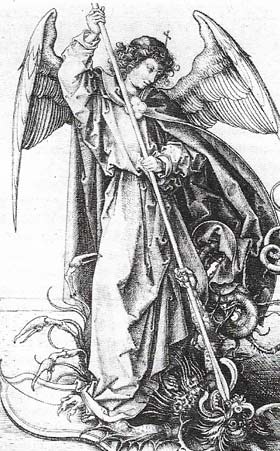 |
| Martin Schongauer's engraving of St Michael (c. 1475) is closely related in style to contemporary German wood sculpture. Schongauer regularly signed his work and is in fact the earliest northern engraver known by name. His work formed one of the major channels of northern influence on Italian painters such as Giorgione, while one of the earliest works by Michelangelo, the "Temptation of St Anthony" (c. 1490), was a painted copy of a similarly spiky, fantastic design. Schongauer published more than 100 prints. Covering a wide range of sacred and profane subjects; their combination of rich invention and disciplined clarity makes them particularly attractive. |
German sculpture, by the end of the century the liveliest of northern schools, was also transformed by Dutch influence, mainly through the activity in several German centres of Nicholas Gerhaert of Leyden (flourished 1463–1473), who brought to the Gothic style a richer variety of surface through strong undercutting. The masters of this final quasi-Baroque stage of Gothic sculpture were the exuberant Veit Stoss (Figure 3) (c. 1440–1533, born Nuremberg but 1477–1496 mainly in Cracow) who, typically, worked as much in limewood and boxwood as in stone, and the more restrained Tilman Riemenschneider (c. 1460–1531).
Virtuosity in architecture
Architecture was far from conservative in this period. Builders pursued virtuosity and enormous scale in their work, as in a number of Netherlandish town halls, notably Brussels (begun 1402). The most inventive results were in spectacular vaulting systems, above all in England, especially by delicate fan-vaults, sometimes with pendants, and in Germany by ever more complex geometry of rib patterns.
